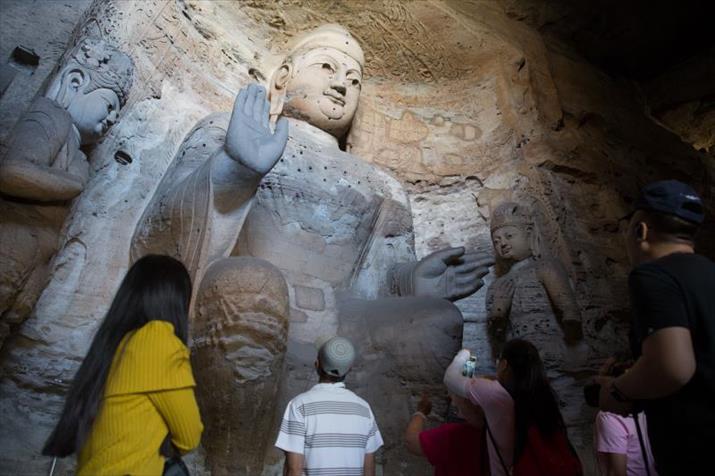| Lifestyle |
| When Faith Moved Mountains | |
| A Sri Lankan visits the historic Buddhist sculpture site of Yungang | |
|
|
 Visitors appreciate Buddhist sculptures at Yungang Grottoes in Datong City, Shanxi Province, on June 11, 2016 (CFP)
It is believed that Buddhism reached China through the Silk Road around the first century A.D., and subsequently, Buddhist arts and crafts arrived from countries like India, Nepal and Sri Lanka. An example would be the artworks found in grottoes built along the Silk Road in China. The Mogao Caves near the city of Dunhuang in Gansu Province in northwest China, the Longmen Grottoes near Luoyang in central China's Henan Province, and the Yungang Grottoes near Datong in Shanxi Province in north China are the three most important places in the country where Buddhist grottoes have been found. The most famous and beautiful artworks among them are those in Yungang, built in the fifth century. I had the privilege of viewing these historical masterpieces in August 2016. At the base of Wuzhou Mountain west of Datong lies a beehive of grottoes, about 1 km long. There are 45 main grottoes out of the 252 and about 51,000 statues. Tan Yao, a Buddhist prelate who lived there during the Northern Wei Dynasty (386-534), was instrumental in the construction of the grottoes. He received the patronage of 54 merchants engaged in trade along the Silk Road, as confirmed by an inscription found at the location, which is a top-rated calligraphic work as well as the oldest and most elaborate record about the building of the Yungang Grottoes. According to history, the monk was in charge of cutting five caves in the western suburbs of Datong, referred to as the five caves of Tan Yao. As a mark of respect to the prelate, his statue was erected at the entrance of the historical site. The other major caves in the cluster were mostly completed in the following decades. It is believed that more than a staggering 40,000 craftsmen toiled to create the grottoes and statues, most of which were built according to the Gandhara tradition, a Buddhism-based school of art that flourished in an ancient kingdom encompassing what is today parts of Pakistan and Afghanistan. I was surprised when my coordinator, Chen Luying of the Foreign and Overseas Chinese Affairs Office of Shanxi, told me some of these statues were from Sri Lanka. In the history books of China, Sri Lanka is referred to as the Kingdom of Lions. The arts and crafts that flowed to China through the Silk Road mixed with the indigenous culture in China and obtained their present form. That can be found in the Yungang Grottoes today. The terrain divides the grottoes into three natural but neat clusters: eastern, central and western. The caves in the east mostly house pagodas called pagoda caves. Those in the central area have front and rear chambers with the main Buddha figures sitting in the middle and reliefs on the ceiling and walls. The caves in the west are smaller. This place is a treasure trove of Buddhist art, sculpture, statues and murals of gods and goddesses, birds and animals, beautiful flowers and exotic plants as well as images of those who sponsored the building of the grottoes. Some of the Buddha statues are extremely beautiful and the tallest of them is about 16 meters. They express love and compassion. The Buddha statue found in Cave 12 is 13 meters in height and a true representative of the Yungang Grotto art. It reminds me of the Samadhi statue at Mahamevuna Uyana in Anuradhapura, capital of Sri Lanka's North Central Province, which shows the Buddha in the highest state of meditation. It is recorded that in the fifth century, the then emperors of China and their immediate families had private temples. Some of the statues in these temples portrayed different stages in the Buddha's life. Some showed him as preaching with celestial beings showering flowers from heaven. In Cave 20, dancers and musicians celebrate Siddhartha, the prince who left his home in search of enlightenment, becoming the Buddha or the Enlightened One. These statues are beautifully sculptured and the attire of the figures resembles what people actually wore during that time. In the course of time, the Yungang Grottoes became a turning point in the development of Buddhist art in China. The statues of both Mogao and Longmen were influenced by Yungang, which has the largest collection of grotto art in China. Yungang was inscribed in the UNESCO World Heritage site list in 2001. The author is vice president of the Sri Lanka China Society Copyedited by Sudeshna Sarkar Comments to yanwei@bjreview.com |
|
||||||||||||||||||||||||||||
|
